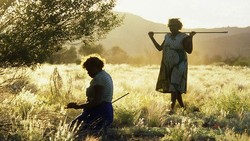
In the lower basin of the Ord river in Western Australia indigenous people number between 40% and 50% of the population. (Photo: Wildlight)
Colonizing - and selling - the Ord: an Australian tale with a message
by Jessica McLean
For indigenous people in Australia a colonial history of dispossession carries forward into a present in which they are, only since 1993, able to reclaim title to at least some of the land their ancestors lost. Where they are relatively numerous, their new legal power should – one would think -- receive added weight. In the lower basin of the Ord river in Western Australia (WA) near the Northern Territory (NT) border, indigenous people number between 40% and 50% of the population. This region is normally dry for 8-9 months each year, and water is the element which gives value to land – least for a forager, more for a pastoralist, most for a farmer. Because indigenes were foragers, their water needs could be and have been ignored.
Pastoral occupation by large cattle stations dominated the regional economy from the 1880s to the 1960s. For workforce, they mainly employed indigenous people whose land they had seized – cheap labour until pastoral wages were compulsorily equalized in 1968. In 1963 irrigated farming began in the lower basin on some 130 sq.km fed with Ord water below a (low) Diversion Dam at the site of a new town. The crop was cotton, then rice. Both failed due to pest and cost problems. Many settlers turned to growing fruit and vegetables -- giving work mainly to back-packing tourists. Recently sandalwood, demanding little labour, has dominated. Further up the valley is a profitable diamond mine, formerly opencast but recently gone underground to extend its economic life a little beyond 2020. The mine became the principal customer for the (high) Ord Main Dam completed in 1972, which holds back hugely more water than is needed for present irrigation, but drives a 30 MW hydro-power station which supplies the mine.
Before the 1990s the pre-colonial people received scant mention in all this, but after Native Title was legislated in 1993, a claim by the indigenous Ord people was among many lodged. It was hotly contested by the WA government, among others. Negotiation became necessary leading to the Ord Final Agreement (OFA) in 2005, since when indigenous rights and needs have found a prominent place in at least all rhetoric concerning the Ord. The OFA says nothing about water and this still-very-colonial omission is pointed out and explained in two papers by Jessica McLean of Macquarie University in Sydney (NSW), the second of which (McLean 2014) formed the trigger for this PLECserv. McLean cogently argues that indigenes be involved in all decisions about water, resting her case on a careful analysis of changes up to around 2008. She does not cover dramatic subsequent developments. The rest of this PLECserv, for which HB and MB take full responsibility, summarizes the latter.
Not far below the Diversion Dam the present Ord turns west through hills to the nearby sea. Further east, following ancient channels of the river, a series of alluvial-floored valleys with very gentle slope reaches the sea well inside NT. This tempting irrigation opportunity was neglected for over two decades while many thought Ord irrigation a costly failure. The Ord no longer drew pioneer-spirited settlers such as came in the 1960s; it was now fashionable to seek agribusiness. Some detailed plans were prepared by national developers in the 1990s but they then withdrew. Only after the OFA did private investors sustain interest.
The WA government funded further irrigation works in 2010 and called for tenders to develop 134 sq.km up to the NT border, under 50-75 year lease. Out of three contenders preference went to a specially-formed Chinese company wholly owned by a large Shanghai-based conglomerate without agricultural experience, even in China. Entry of big capital seeking scale re-opened the question of the immediately-adjacent 145 sq.km of Ord-irrigable land in NT. With the bureaucracies of two states involved, and federal bureaucrats as well on the sensitive environment-protection issues, progress is slow. Physical work began on the first section in WA in 2013 and a second in 2014. But land title matters in NT are only now being negotiated. The OFA was restricted to WA.
Indigenes are being employed, some in skilled work, for land preparation. Future participation is scarcely in a decision-making capacity. A few indigenes might become irrigation farmers on limited areas reserved from the lease, or as tenants. Receiving a sandstone ridge for co-management as a conservation reserve, leaders remarked that for traditional activity, indigenes want flat land with river access. In the new economy, such allocations seem improbable.
The crop intended was sugar cane, supplying a proposed mill that was central to official expectations. The company insists that the whole 280 sq.km, in both WA and NT, must be developed before this can happen. They also propose to upgrade the nearby port of Wyndham for both import and export traffic, with the same condition. Clearly this will not be soon so – for now -- sweet sorghum processed for ethanol becomes the designed crop. So much for the Ord as a ‘food bowl’. So much too for a new partnership with indigenous people. As in transactions with land-grabbers in poorer lands, the valued partnership now is with big money.
To communicate with Dr McLean, or request single copies of her papers, write to [email protected].
McLean, J. 2012, From dispossession to compensation: a political ecology of the Ord Final Agreement as a partial success story for indigenous traditional owners, Australian Geographer 43 (3): 339-355.
McLean, J. 2014, Still colonizing the Ord River, northern Australia: a postcolonial geography of the spaces between indigenous people’s and settlers’ interests, Geographical Journal 180 (1): 196-210













